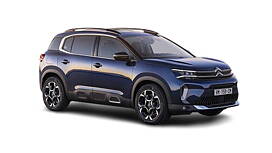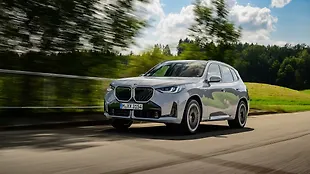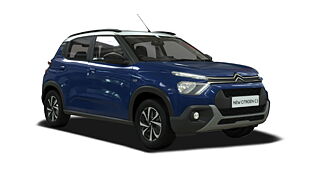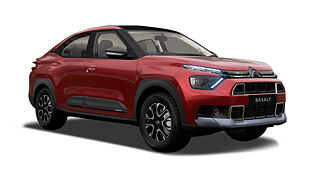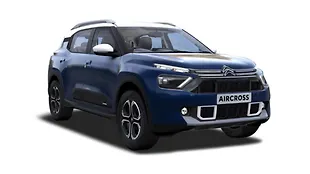Why would I buy it?
- Strong diesel drivetrain
- Funky design inside and out
- Flexible seating arrangement
Why would I avoid it?
- More expensive than before
- Limited after-sales network
- Diesel clatter filters into the cabin
What is it?

The Citroen C5 Aircross was the first model to be launched by the French marquee almost two years ago. A facelift has been in the pipeline since then, but this update brings in a lot more. Citroen claims that the new seats and revised suspension further enhance comfort. The former, called the ‘Progressive Hydraulic Cushions suspension’ by the company, claims to enhance the absorption of imperfections in the road and ensure that passengers travel in absolute comfort, along with a natural ‘flying carpet’ effect. But how much of a difference does it feel in the real world? Let’s find out.
Is the cabin any good?

Welcoming you into the cabin of the Citroen C5 Aircross facelift is a dual-tone black and grey theme. The first thing one is likely to notice would be the lack of a gear lever, which has now made way for a button setup and can also be toggled via the silver switch. This new setup sits on a redesigned centre console, which houses the new 10-inch touchscreen infotainment system above the new, horizontally positioned AC vents. Further below are the touch-based buttons that give access to various functions via the screen including music, temperature control, navigation, calls, and settings. As I became comfortable, I noticed the leather elements on the dashboard and the steering wheel. That said, the quality of plastic on parts such as the door pads could be better considering the price and the segment the C5 Aircross comes in.

The front seats are relatively wide and comfy, and the side bolstering is enough to make it noticeable, though not as snug as a performance-oriented car would. But then that’s not what Citroen is aiming at anyway. The priority here is comfort, and that is there in plenty. We did miss the ventilation on these seats though, more so due to the humid weather on that particular day. Carried over from the previous iteration are the electrically-adjustable driver seat and manually adjustable front passenger seat. What did bother us in particular though, was the recline function for the latter, which involved rotating a knob multiple times, unlike most cars which have a lever and get the job done quicker and easier. Moving over to the second row, you have, unlike most cars in the market today, three individually carved-out seats in a 40:20:40 ratio. All three of them can be folded or reclined based on one’s requirements, be it moving houses or hauling a surfboard. The legroom is plenty, and the under-thigh support is just about adequate. There are subtle blue stitchings all across the seats and dashboard which make for a good contrast with the grey theme of the seats, which otherwise get a white stitch pattern.

The boot can be accessed by sliding a leg below the rear bumper, giving access to 580 litres of space to store luggage. Fold the second-row seats and this number almost triples to 1630 litres. There are also hooks where customers can mount nets or loop, but only up to a permissible capacity of 100kg. The inside of the tailgate, which houses the button for the electrically closing boot lid, also gets a separate section to keep the hazard triangle. Cubby holes and small storage spaces too are in good numbers. The front row gets space to sow away items below the hand rest, including a small separate section for coins and toll receipts. Sitting right ahead are two cup holders, while the glovebox has two sections, one of which can be cordoned off for a valet with the help of a key. The doors can easily take in a one-litre bottle, and then some more knick-knacks. The instrument console gets a minor design update too and is now cleaner than before. Sitting at its top is the tachometer, and positioned below it is the speedometer, all in the digital avatar. The smaller console on the right displays the gear position and temperature gauge. At the same time, the one on the left showcases the fuel gauge and various other menus, including the drive modes, which can be toggled via the steering-mounted controls.
Is it nice to drive?

At the heart of the Citroen C5 Aircross is a 2.0-litre, four-cylinder diesel engine that generates a maximum power output of 174bhp at 3,750rpm and 400Nm of torque at 2,000rpm. Sending power to the front wheels is an eight-speed torque converter automatic transmission that can also be controlled via the paddle shifters. The engine is nice to drive, and as far as it isn't being pushed, it feels refined. Dabbing the accelerator isn’t exactly necessary with the Citroen C5 Aircross as there is loads of low-end torque and minimal turbo-lag. The gear shifts are smooth and quick as the pace begins to build. But whenever you feel like taking control, you have those paddle shifters at your disposal. Bury the throttle and you’re off to an instantaneous start, and you can feel the engine gushing out all the available torque there is to offer. Pushing the car also means that the diesel engine’s noise filters into the cabin at higher RPMs, though it makes its way out as you return to cruising speeds.

The drive mode selector button is placed on the centre console, while the changing modes are reflected in the instrument cluster, which we found somewhat unconventional. There are six modes on offer: Sport, Normal, Eco, Sand, Mud, and Snow. Our conditions allowed us to try only the first three, and as expected, the modes lived up to their respective names. In Sport mode, the power delivery is instant and the gears are held on to for a marginally longer period, while in Normal mode, the power delivery is linear, and gear shifts are smooth. In Eco mode, the power delivery is dull, and upshifts come in early in order to squeeze out the maximum FE from the car.

The suspension, which Citroen refers to as the ‘Progressive Hydraulic Cushions’ does a good job at low speeds and this only gets better as the engine starts spinning faster. This does mean that bumps at low speeds in the city and the likes will be felt, more so if they are the kinds you find on the streets of Mumbai.

The imperfections on the road can be felt on the go at lower speeds, although this doesn’t essentially affect the composure of the occupants in the car. The steering is light, which certainly helps during those choc-a-block traffic situations or when you have a tight spot to find parking your way through. While the suspension is still on the softer side, it sure does feel planted on the highway, or even in the city for that matter, unless you plan to throw in a few corners. The latter is where the body roll will make its presence felt, courtesy of the high ground clearance and the longer travel suspension.
Should you buy it?

The Citroen C5 Aircross facelift is a different approach and is the one that will probably stand out than blend in, be it the design, the quirky interiors, or the impressive engine and gearbox combo. Comfort is a priority, and Citroen has made it a point to do everything it can to give the best possible combination when it comes to this. There are a few minor gripes like the low-speed ride or the sparse sales and service network. To cover the latter, the brand also offers the ‘Citroen Future Sure Package’ which includes Routine Maintenance, Extended Warranty, and Roadside Assistance among others. All said and done, the Citroen C5 Aircross facelift definitely is an enticing package if the sticker price doesn’t pinch you. Rivals to the model in this price range include the Jeep Compass, Hyundai Tucson, and the Volkswagen Tiguan.
Pictures by Kaustubh Gandhi

